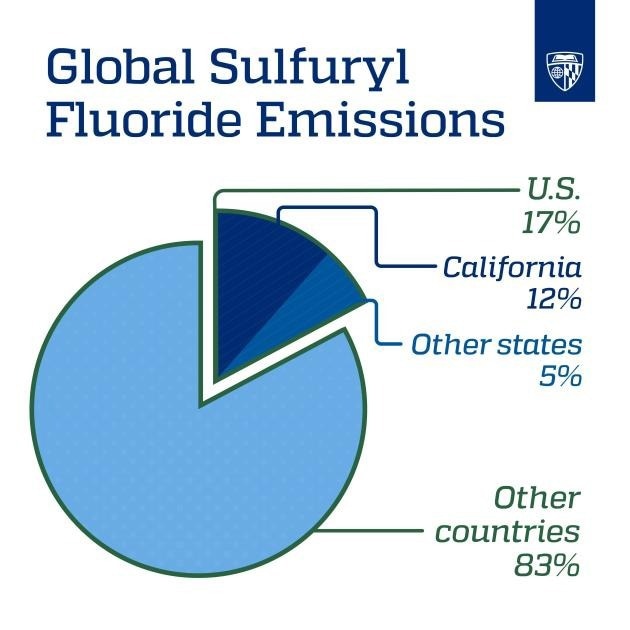California, a state recognized for stringent greenhouse gas reduction regulations, is, unfortunately, the country’s largest emitter of one: sulfuryl fluoride.

The United States is responsible for as much as 17% of the global emissions of sulfuryl fluoride, a potent greenhouse gas. About 60-85% of U.S. emissions come from California, according to a study published in Communications Earth & Environment. Image Credit: KHAMAR HOPKINS/JOHNS HOPKINS
The United States accounts for up to 17 % of worldwide emissions of this gas, which is a common pesticide used to treat termites and other wood-infesting insects. According to a new study done by Johns Hopkins University researchers, the bulk of these pollutants originate in just a few counties in California.
When we finally mapped it out, the results were puzzling because the emissions were all coming from one place. Other greenhouse gases like carbon dioxide and methane are found everywhere across the US On our sulfuryl fluoride map, only California lit up like a Christmas tree.
Scot Miller, Study Co-Author and Assistant Professor, John Hopkins University
More than 15,000 air samples that NOAA Global Monitoring Laboratory scientists gathered between 2015 and 2019 were examined by Miller and lead author Dylan Gaeta, a Ph.D. candidate at Johns Hopkins. Wind direction, speed, and other meteorological variables were taken into account by the researchers to determine the origin of the chemicals.
Despite California being a national leader in reducing greenhouse gas emissions—publishing a comprehensive plan to achieve net-zero emissions by 2045, among other things—the team found that 60–85 % of sulfuryl fluoride emissions in the US originate from California, primarily Los Angeles, Orange, and San Diego counties.
We can now show not only where but also how and why this gas is being emitted. In order to get to net-zero emissions, we need a complete inventory of what greenhouse gases are out there.
Dylan Gaeta, Ph.D. Student, John Hopkins University
The research was recently published in the journal Communications Earth & Environment.
Sulfuryl fluoride was first authorized by the U. Environmental Protection Agency for use as a pesticide in 1959. According to the researchers, the substance gained favor when countries decided to phase out more reactive fumigants that were destroying the ozone layer.
Thanks to California's meticulous record-keeping on pesticide usage, the researchers were able to trace approximately 85 % of the state's emissions of sulfuryl fluoride back to structural fumigation. This process involves enclosing an infested building within a sealed tent, introducing gas to eliminate the pests, and then releasing the gas into the atmosphere. The remaining 15 % of emissions were attributed to fumigation in agriculture and commodities.
The researchers explained that once released, the gas disperses and remains in the atmosphere for over 40 years, playing a role in global warming by trapping heat and reflecting it back to the Earth's surface. Although the average atmospheric concentrations of sulfuryl fluoride are low, humanity has been emitting this synthetic gas for decades at a pace that exceeds its natural breakdown rate.
Gaeta added, “Without some form of intervention, sulfuryl fluoride is going to keep accumulating in our atmosphere. For most greenhouse gases, California has been very intentional about how it's going to reduce emissions. This one has slipped under the radar.”
Carbon is the most significant threat to global warming; therefore, efforts to limit greenhouse gas emissions tend to focus on that gas. However, Miller stated that academics are attempting to have a more comprehensive understanding of the threats posed by other greenhouse gases.
Sulfuryl fluoride is one of the few treatments that can eliminate drywood termites, a prevalent regional pest that can establish colonies in high, difficult-to-reach areas of wooden structures. It is also used in shipping ports to eliminate pests before they spread to other regions of the world.
“It really is a double-edged sword. Sulfuryl fluoride is less harmful than the banned fumigants, but it also contributes to global warming. California’s track record shows that it is been looking at out-of-the-box, creative ways to reduce its greenhouse gas emissions. I think knowing better what the emissions are and what impact they have will give the state the information it needs to help holistically develop greenhouse gas reduction strategies,” Miller added.
The results were shared with the California Air Resources Board and the Bay Area Air Quality Management District.
Journal Reference:
Gaeta, D. C., et. al. (2024) California dominates U.S. emissions of the pesticide and potent greenhouse gas sulfuryl fluoride. Communications Earth & Environment. doi:10.1038/s43247-024-01294-x